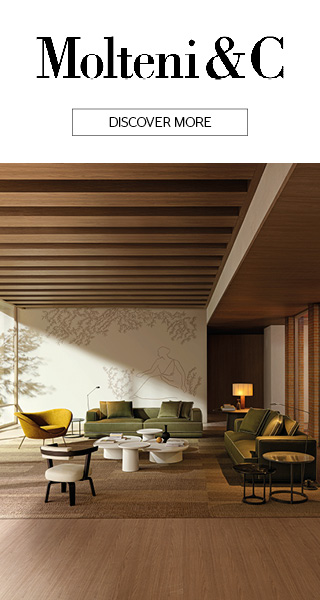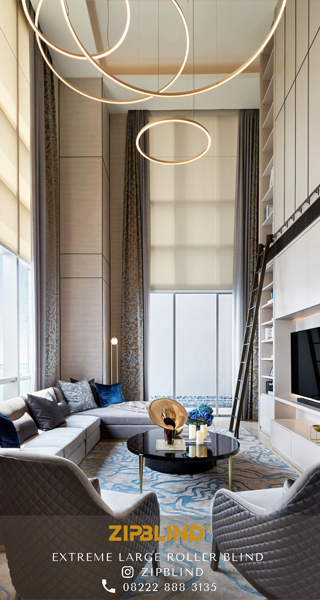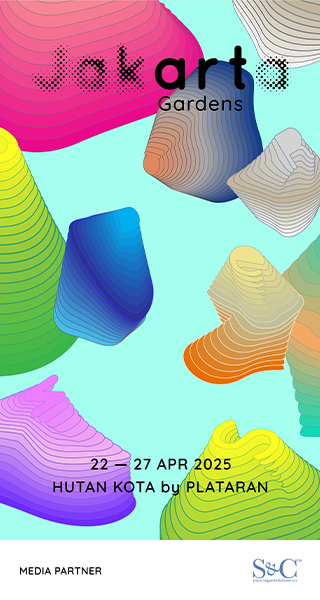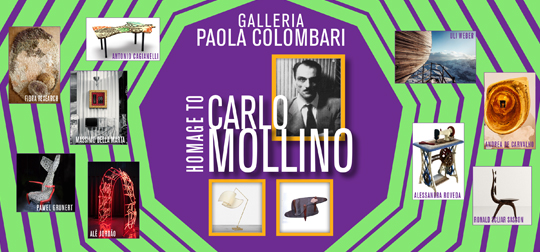
GALLERIA PAOLA COLOMBARI X LANIERI – “HOMAGE TO CARLO MOLLINO”
Published by Sugar & Cream, Tuesday 23 May 2023
Images courtesy of Galleria Paola Colombari
@Milan Design Week 2023
Galleria Paola Colombari in collaboration with Lanieri inaugurates the exhibition “Homage to Carlo Mollino” on Tuesday 18 April 2023 on the occasion of the Milan Design Week during the Salone del Mobile, for the fiftieth anniversary of the death of the great architect from Turin (1905-1973).
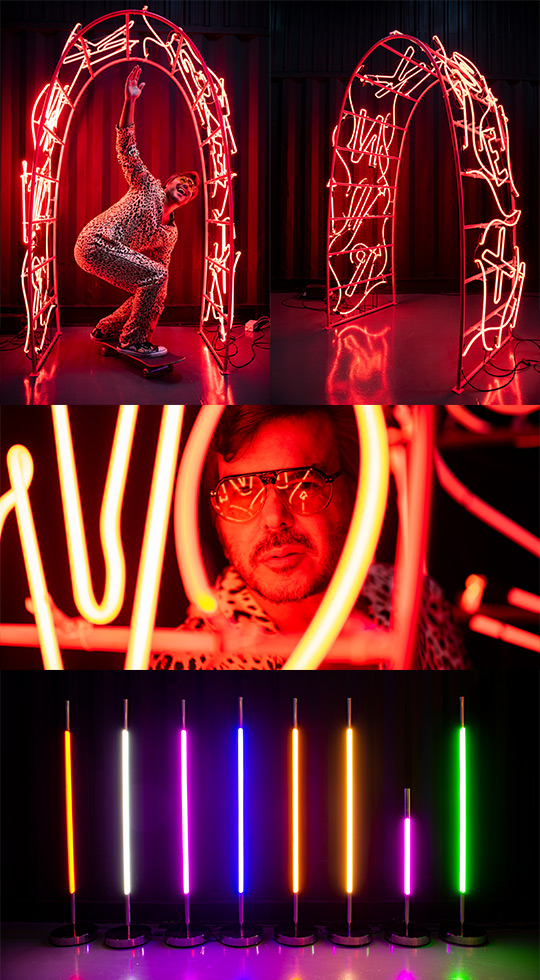
Alê Jordão
On display will be a selection of works by well-known international art designers in homage to the great “Maestro” such as the Brazilians Ronald Scliar Sasson and Alê Jordão, the Pole Pawel Grunert, the Italians Antonio Cagianelli and Alessandra Roveda, the Fibra research duo of Adriana Fortunato and Caterina Fumagalli, the international photographer Uli Weber and the artist Andrea de Carvalho.
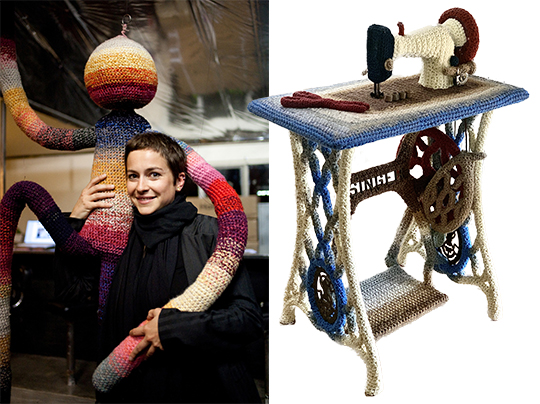
Alessandra Roveda
The exhibition will feature the work ‘Devalle Love’ Wine frame in homage to Carlo Mollino by designer Massimo Della Marta. Also on display will be some important works from the “Homage to Carlo Mollino” collection published by Edizioni Galleria Colombari since 1994, such as the famous “Lampada Suora”, the “Boomerang” coffee table and the “Erotico” clothes stand. The exhibition will be articulated through the creation of settings of Carlo Mollino‘s furnishings such as “Casa Devalle” (Turin 1940), “Casa Miller” (Turin 1938), the “Lutrario Ballroom” (Turin 1959), the ‘Singer & Sons’ shop (Turin 1950) and some architectures such as the ‘Casa del Sole’ in Cervinia (1947/54) and the beautiful Fürggen cable car station (Cervinia, 1951/53) photographed by Uli Weber, which will provide a backdrop to the beautiful art design works on display.

Presented by Zipblind
If he had not been born in Turin on that morning of 6 May 1905, we would never have had the pleasure of getting to know the extraordinary, medium-sized architect Carlo Mollino, a 20th-century genius who left an indelible mark on all his passions as a great forerunner of post-modernism and an elusive, Leonardesque experimenter of avant – garde languages from architecture to design, to his beautiful furniture, to photography, to flying machines such as his extraordinary Bisiluro, to his passion for aeroplanes, to his passion for skiing for which he wrote a manual and was a great friend of the champion Leo Gasperl. Without knowing it, Carlo Mollino was a Marinettian futurist and elusive in all his manifestations, but always poised between perfect aesthetics and the dynamics of form that defined him as a forerunner of the modernist languages of the 1950s.
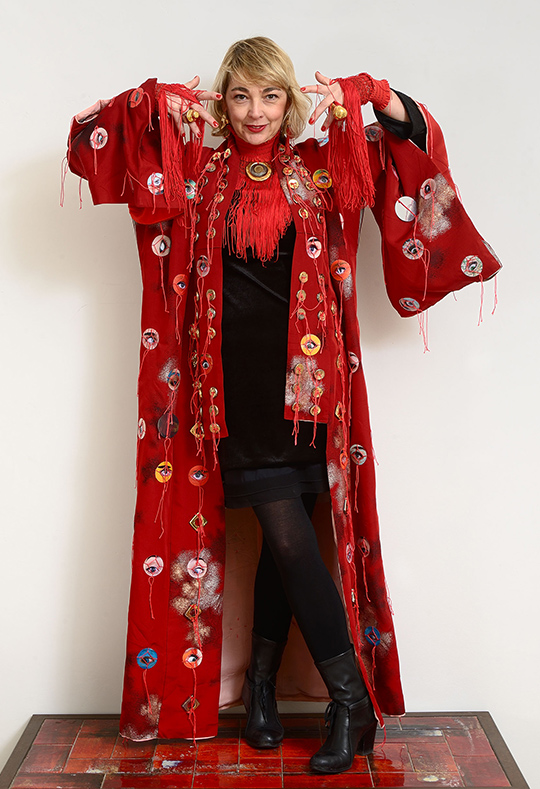
Andrea de Carvalho
The exhibition begins with the artist Alê Jordão, who interprets a wonderful light installation in homage to the Sala da Ballo Lutrario, designed by Carlo Mollino in 1959 in Turin. Also known as ‘the light man’, Alê Jordão presents the neon installation ‘Carnaval’.
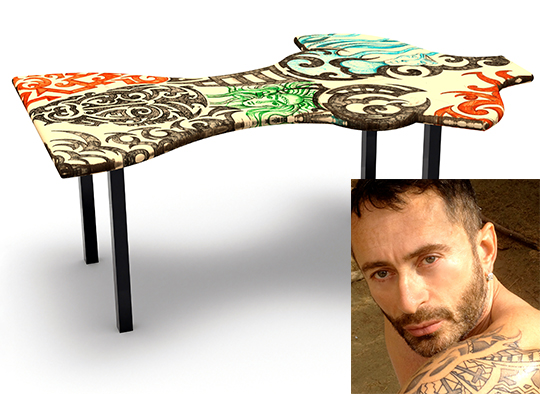
Antonio Cagianelli
“I was very impressed by Carlo Mollino‘s extraordinary work, his pop surrealist scenographic vision of the former Lutrario cinema, today Dancing Le Roi, in Turin,” explains the art designer, who was inspired by the playful and colourful lighting effects proposed by the Italian architect. The installation reveals itself through a 1 meter wide and 2.20 meter high arch made of iron painted pink with the neon inscription Sexy Pink. “It is my welcome to visitors, an invitation to get to know my irreverent version of the ‘Lutrario’,” explains Jordão, who will transform one of the gallery’s rooms into a real ballroom. The visitor passes through the arch and comes across another installation inspired by neon-coloured geometric shapes with five 1.60 metre high floor lamps in yellow, blue, orange, green and pink. The same colours that Carlo Mollino used in his original project.
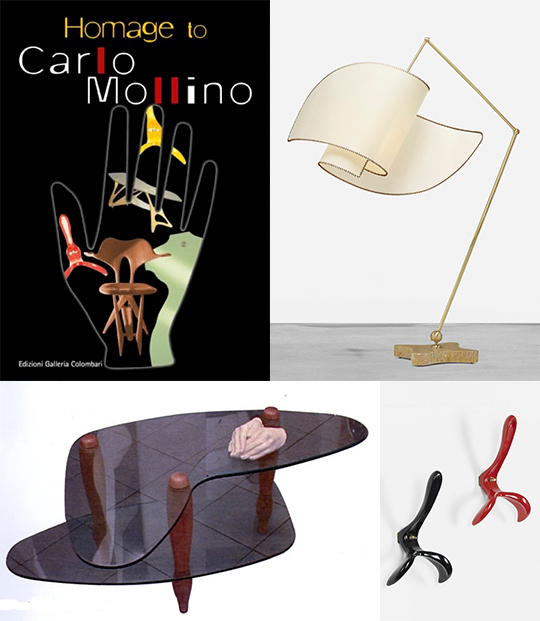
Edizioni Galleria Colombari
The second room is dedicated to the project for the cable car station on the Fürggen ridge in Cervinia (1950-52). With a series of photographs, photographer Uli Weber captures the aerodynamically shaped structure, heroically embedded in the overhanging rocks towards Breuil. The extreme environment and the need to confront the strong high-altitude winds become an opportunity to reflect on language at the intersection of form and technique. The existing building in poor condition and no longer in use, stands in a state of disrepair at a high altitude of 3,492 metres and takes on the charm of an archaeological relic. In the exhibition, Uli Weber‘s photo Fürggen in Homage to Carlo Mollino, printed in Fine Art on Canson Baryta paper and mounted on Diasec, makes us feel the beauty of the neo-organic and dynamic form of Carlo Mollino‘s project.
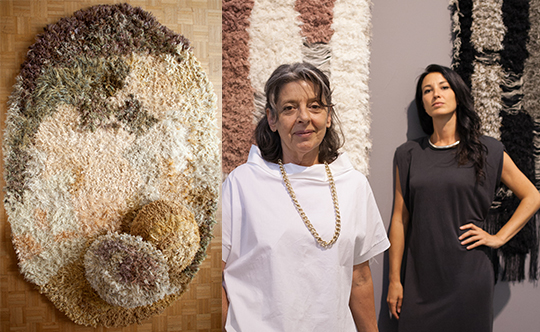
Fibra research
The installation by art designer Alessandra Roveda presents an interpretation in homage to the “Casa del Sole”, designed by Carlo Mollino in Cervinia in the years 1947-55. On show is Homage to the ‘Casa del Sole’ chair, a limited edition re-edition of the oak and brushed brass seat covered in crochet worked by hand by the artist. The installation of skis, boots, bobsleighs, all covered in crochet, brings to life the futuristic concept of the ‘typical flat’ that Mollino designed in the early 1950s. The Casa del Sole was in fact conceived as a commercial operation for a Cervinia that, still without a master plan, was on its way to becoming one of the most internationally renowned winter tourism centers.
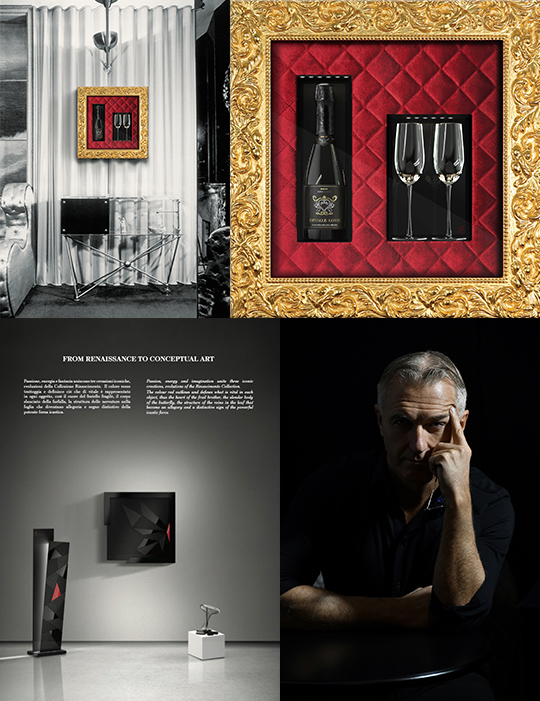
Massimo Della Marta
Polish art designer Pawel Grunert is inspired by the famous ‘Casa Orengo’ among Carlo Mollino‘s most important furnishings, which he nicknamed ‘La Casa verso la collina’ (Turin 1949). The SIE75 armchair, made of stainless steel and wood, is inspired by Mollino‘s red upholstered armchair designed for Marquis Pier Paolo Vladi Orengo. The world of machines, the Baroque and organic forms were reference points in Mollino’s aesthetics. Designer Pawel Grunert proposes a playful mobile structure, where steel and springs move from hard to soft, creating an organic, sensual and surreal scenic effect. The original works of the well-known ‘Casa Orengo’ were auctioned for the first time in the world by Paola and Rossella Colombari, in the auction they curated in 1985 for the Semenzato Auction House at Palazzo Giovanelli in Venice. The auction marked not only Carlo Mollino‘s first international success, but the birth of Modernism collecting.
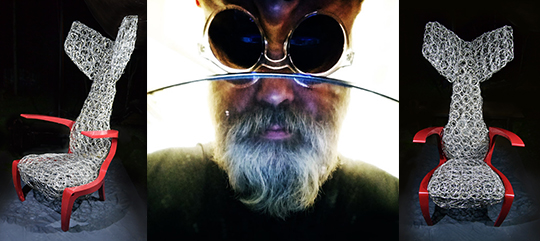
Pawel Grunert
Art designer Antonio Cagianelli presents the coffee table ‘le diable au corp’ in hand-painted Deruta ceramic from the Gialletti factory. The work was created as a counterpoint to Homage to the Milo mirror by Carlo Mollino and is to be read as the materialisation of the reflection, the afterlife of the mirror. It is the reflection of a contemporary Venus, contradictory and ambiguous with her painful experiences on her skin, with her struggles won and lost. A Venus at once whole and imperfect in continuous metamorphosis between purity and threatening influences of evil. A graphic/ pictorial and conceptual work halfway between street art and mythology, esotericism and urban culture.
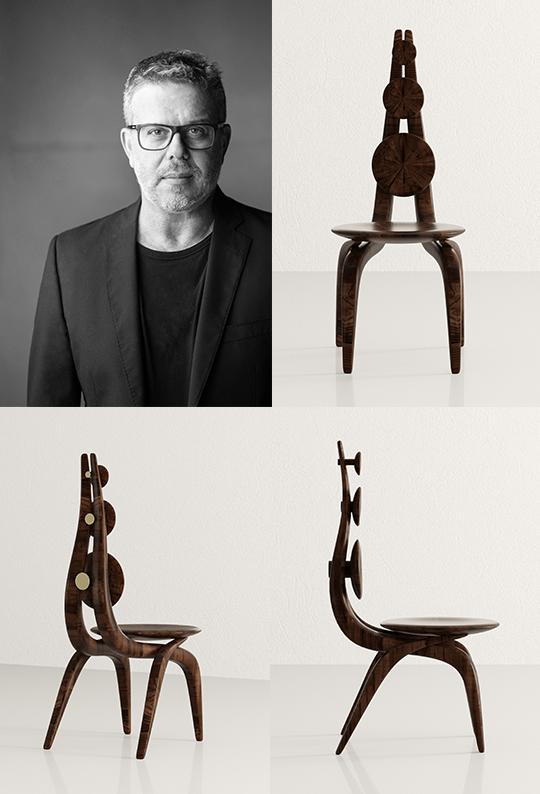
Ronald Scliar Sasson
Massimo Della Marta, designer & engineer and founder in 2004 of his own company Expo, with the aim of giving shape and material to all his projects, dedicates his Homage to ‘Casa Devalle’ (Turin 1940) ) among Carlo Mollino‘s most fascinating furnishings. ”Entering the world of Carlo Mollino, studying the character and his great works was a unique experience, while at the same time inspiring and exciting. When I saw the photograph of Casa Devalle, I had no doubt. That was where I would set my work. Mollino created a “garçonnière” for Devalle, a magical and surreal environment where, defying all conventions, he makes the structure of the lamps break through a curtain and in front of it he places the beautiful mirror and metal console. A surreal installation that Massimo Della Marta sought to follow by placing “Devalle Love” in front of the same curtain. The work follows the style of the surrounding environment. Baroque style frame with 24 kt gold leaf, black mirror background contrasting with the matt black structure and quilted red silk velvet trim, a pattern used by Mollino for other elements of the house. “I am sure that if in 1940 this particular Wine frame had already been invented, Carlo Mollino would have wanted it for Casa Devalle, or at least, in my dream, that’s what I want to believe”.

Uli Weber
Brazilian art designer Ronald Scliar Sasson dedicates his Homage to the chair designed by Carlo Mollino for Casa Rivetti (Turin 1949). The beautiful and fascinating ‘Polipo’ chair, designed in a limited edition, elegantly interprets Mollino‘s neo-organic forms. For Ronald Scliar Sasson, “Carlo Mollino always had a strong surrealist appeal, his work developed between the utilitarian and the sculptural, almost always based on nature and its contours with organic and zoomorphic volumes. In my project in Homage to the Chair for Casa Rivetti, I see a second possible inspiration from Mollino in the octopus with its tentacles, of which I interpret in my work a very appropriate interpretation of this animal in full balance with his work made of imbuia, solid Brazilian wood, and brass details”.
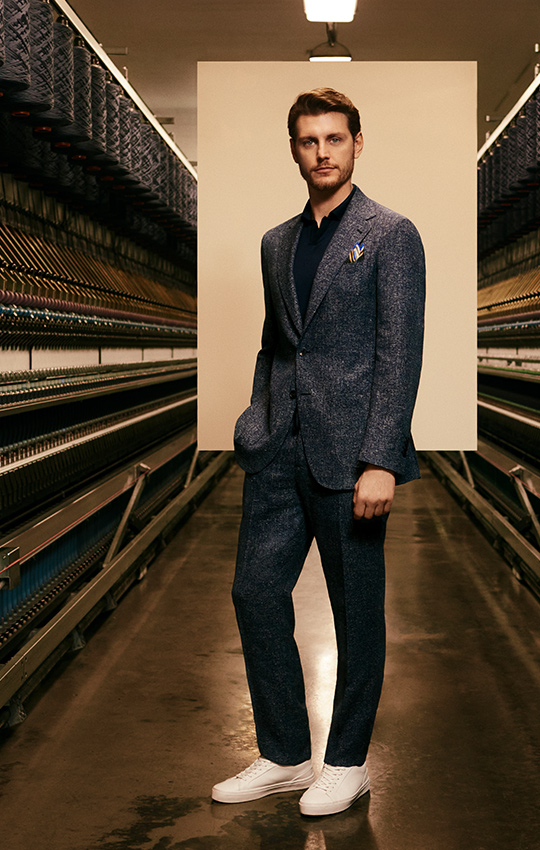
In the magical room dedicated to the homage to “Casa Miller” (Turin 1938), one of Mollino‘s most sensual and theatrical works, designers Adriana Fortunato and Caterina Fumagalli, founders of the research brand Fibra, propose the reinterpretation of a poetic environment, where, as in a boudoir, the “Boomerang” coffee table designed by Carlo Mollino and produced as a tribute by Edizioni Galleria Colombari, will merge with “Sensualis a textile work handmade by Adriana Fortunato and Caterina Fumagalli” The elegant Fibra research work is described by the two artists as “A sensual organic element of soft fabric and interwoven shades, capable of merging with the elements of space. It is a carpet to caress, to lie on and rest on its cushions. It is a unique piece made exclusively for this exhibition and inspired by the rooms of the Miller House. The carpet can also transform and become an element to be placed on a sofa or hung on a wall, it has a changing and free soul, like all our works.”
The Brazilian artist Andrea de Carvalho dedicates a Homage to Carlo Mollino with the work ‘Meteorite Venere‘, a ceramic sculpture fired with the third fire with an illuminated photograph inserted and a small photographic shot inside, in homage to the Polaroids of Carlo Mollino‘s Muses.
The exhibition continues in the beautiful Lanieri space where the artist Alessandra Roveda dedicates her homage to the “Singer & Sons shop” (Turin 1950) designed by Gio Ponti in Via Roma in Turin, where Carlo Mollino created some furnishings including the famous “Arabesco” coffee table. Alessandra Roveda dedicates the Homage by reinterpreting a vintage Singer sewing machine, a work of art made of unmistakable weaves and shapes that take us back in time. An icon reinterpreted with the art of crochet, using the same language: weaves, embroideries, yarns. And plays of colour at the service of shapes. Delicate colours, reflecting those of the Lanieri collection. Alongside, sartorial objects, emphasized in shape and size, to accommodate an imagery linked to the art of tailoring. The beautiful work “Singer” is illuminated by the lamp “Suora” published by Edizioni Galleria Colombari since 1994 in the collection “Omaggio a Carlo Mollino” in homage to the 1947 Cadma Lamp. Next to it is the “Sun Chair” by Alessandra Roveda in homage to the chair of the “Casa del Sole” designed by Carlo Mollino in Cervinia (1947-55), the chair is a limited edition re-edition of the oak and brushed brass seat covered in crochet worked by hand by the artist.
 1.08K
04/07/2025
1.08K
04/07/2025
DIOR MAISON RIVIERA UNVEILS A SUMMER SANCTUARY AT SUNDARA, FOUR SEASONS BALI
Dior Maison unveils the new Dioriviera collection at the pop up of Dioriviera, Sundara – Four Seasons at Jimbaran Bay, Bali from July 5 to August 31,...
read more 9.24K
04/07/2025
9.24K
04/07/2025
THE LANGHAM, JAKARTA CELEBRATES MID-AUTUMN WITH ELEGANCE AND ARTISTRY
The Langham, Jakarta unveils its 2025 Mooncake Collection, where refined craftsmanship meets elegance: The Peony & The Plum Blossom presented in the most...
read more 12.12K
17/06/2025
12.12K
17/06/2025
JAIPUR RUGS X PETER D’ASCOLI PRESENTS THE GILDED AGE COLLECTION (2025)
The Gilded Age collection by Jaipur Rugs X Peter D’Ascoli channels the decadent glamour of 19th-century design into bold, hand-knotted rugs that exude...
read more 10.84K
12/06/2025
10.84K
12/06/2025
MOLTENI&C 2025 COLLECTION – THE COLLECTION BY YABU PUSHELBERG, GAMFRATESI, UNIFOR X LSM
MOLTENI&C 2025 COLLECTION – THE COLLECTION BY Yabu Pushelberg, GamFratesi, UniFor x LSM
read more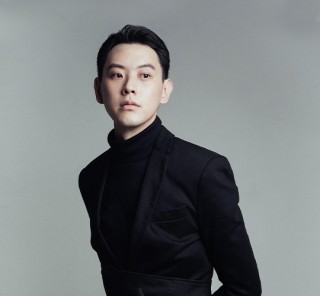 74.65K
10/01/2025
74.65K
10/01/2025
W RESIDENCE IN SOUTH JAKARTA BY MICHAEL CHANDRA
Michael Chandra, founder of MNCO Studio Design has created the W Residence with an aesthetically pleasing, practical, and pleasant home from all...
read more 33.47K
16/05/2017
33.47K
16/05/2017
A Spellbinding Dwelling
Rumah milik desainer fashion Sally Koeswanto, The Dharmawangsa kreasi dari Alex Bayusaputro meraih penghargaan prestisius Silver A’ Design Award 2017.
read more




